
views
- Pour 1⁄4 cup (59 mL) of liquid soap and 1 US gal (3.8 L) of hot water into the toilet bowl to easily break up a clog.
- Run a plunger under hot water for 2 minutes, then plunge the toilet 15-20 times to clear the clog.
- Put a plumbing snake in the hole in the bottom of the toilet, crank the handle until the snake stops moving, then pull the snake out to remove the clog.
Using Soap and Hot Water
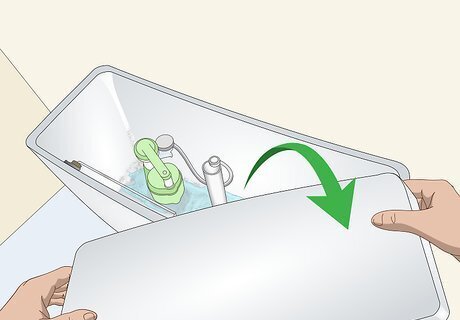
Take the lid off of the toilet’s tank. The lid will be behind the toilet bowl, on top of the water tank. Accessing the water tank allows you to stop the water flow, so you no longer have to wait and hope the water level stops short of the toilet's rim. Lift the lid up with both hands and gently place it on the ground somewhere out of your way. Be careful, since the lid can be heavy and may break if you drop it.

Pour ⁄4 cup (59 mL) of liquid soap into the bowl. Liquid dish soap is the most effective soap you can use. In an emergency, like when you're stuck in the bathroom at a friend's party, you can also try hand soap or shampoo. Add the soap directly to the water so it can lubricate and break down the clog.
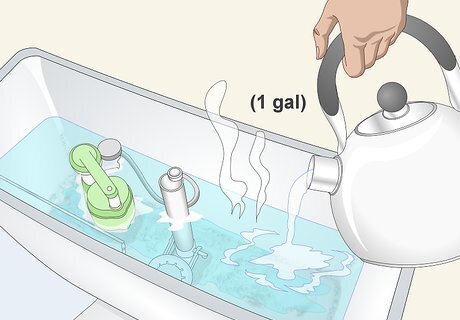
Add 1 US gal (3.8 L) of hot water to the bowl. You may wish to get water from the tap if you are unable to heat water on the stove. The water needs to be hot, not boiling, so it shouldn't be bubbling. Pour the water into the bowl from about waist height. The heat can help melt clogs caused by organic material. Boiling water can crack porcelain, so avoid it at all costs! In an emergency, you can empty out a trash can, then use it to carry water to the toilet.
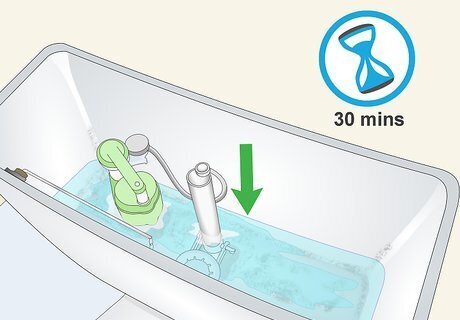
Wait up to 30 minutes to see if the water level goes down. If you can, wait the full 30 minutes to give the soap and water plenty of time to do their work. If the soap and hot water are working, the water level should begin to lower in the toilet bowl. The water may not drain. Check how high the water level is in the bowl to see if you have room to try the treatment again.
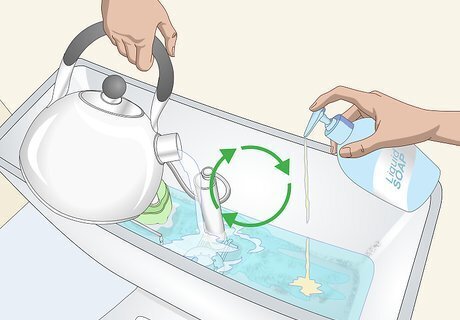
Repeat adding soap and water to the bowl if possible. If you are sure the toilet won’t flood your bathroom, pour more soap into the bowl. Heat up more water, then add it to the bowl as well. You can do this several times as long as you have room in the bowl. If the water looks like it’s about to overflow, stop and consider trying a different treatment. If the water is about to overflow and you don’t want to try something else yet, wait. The water level may go down over time.
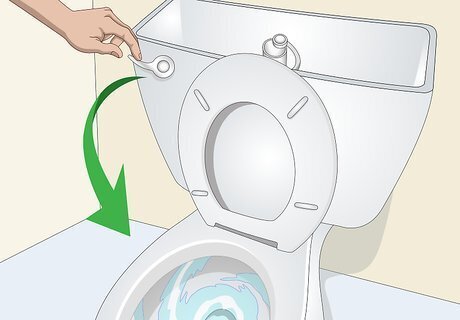
Flush the toilet if the water level isn’t high. Flushing forces the water down into the pipes, which may wash away the clog if the soap and water loosened it. Be careful when doing this, since the toilet will be close to flooding if the water didn't drain at all. Keep the lid off the tank so you can access the water controls. If the toilet seems likely to overflow, you may want to avoid flushing. Instead, wait and see if the water level drops or try using a plunger.
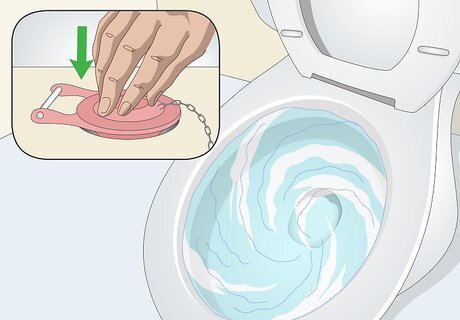
Cover the tank’s water valve if the toilet is about to overflow. Sometimes when you flush the toilet, the clog will stay in place. You can stop the water from flowing by locating the flapper inside the toilet’s tank. It is a rubber valve at the bottom of the tank and is usually colored red or black. Push it down so it fits snugly in the hole at the bottom of the tank. The flapper will most likely have a metal chain attached to it. Pull on the chain to lift or lower the flapper. The water inside the tank is clean, so you don’t have to worry about protecting your hands.
Using a Plunger
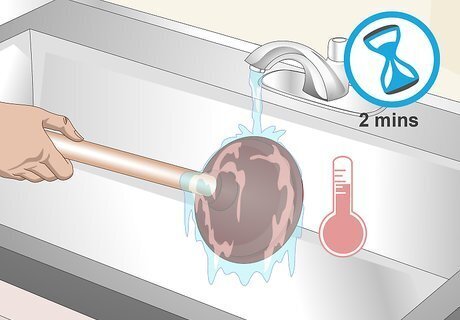
Warm up a plunger under hot water for 2 minutes. Turn the hot water in your sink, then let the rubber, suction cup end of the plunger soak in it. This loosens the rubber so it fits better over the toilet’s opening. You will get more suction powder when you use it. Get a funnel plunger from a general store. This type of plunger has a rubber ring hanging down from the suction cup. Sink plungers have no rubber flange on the bell end. This type of plunger may still work, but it isn’t as effective as funnel plungers.

Fill the toilet bowl with enough water to cover the plunger. If there isn’t already water in the bowl, you will have to add it yourself. You can do this by accessing the flapper inside the tank. If you don't know what it is, look for a red or black rubber plug on a chain. Pull it up to let water flow from the tank to the toilet. The water in the tank is clean, so you can touch it without getting your hands dirty. You can also pour water in the bowl if you need to. Consider using hot water.
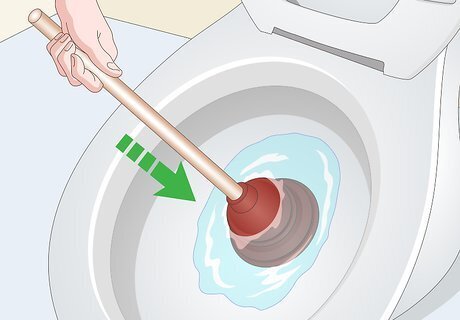
Fit the plunger over the toilet’s exit hole. Put the rubber end of the plunger in the toilet bowl. If your plunger has a flange, the flange piece fits directly into the hole. Push the plunger down slightly to stick it in place. You want the plunger’s bell end to create a nice seal over the hole. You can test the seal by lifting the plunger. It will feel stuck in place at first, releasing air once it pops off.
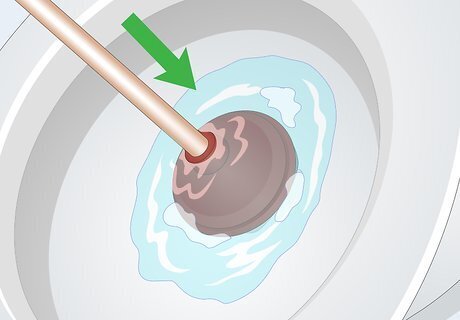
Push the plunger down gently to release air in the bell end. The air in the plunger’s bell end can cause an unpleasant amount of water to splash back at you! Avoid this by releasing the air before operating the plunger. Push the plunger down once, then pull it back up. Once the air is released, you can safely use the plunger without the risk of serious splashback.
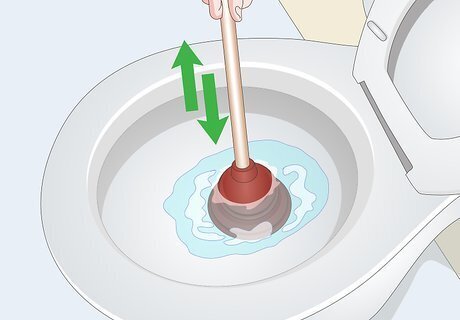
Plunge in and out 15 to 20 times at a fast pace. Work at a fairly rapid pace to keep water flowing around the clog. Push the plunger down hard to send water into the pipes, then pull it back with the same force to draw the water back out. Avoid lifting the plunger off of the exit hole after each thrust. Moving the water into and out of the drainage pipe with equal force increases the chances of the clog breaking up. If you don't have a plunger, you can instead use a toilet brush you'd normally clean with.

Alternate steady plunging with stronger pushes. Plunge the toilet at a constant pace for most of the time. Every few strokes, push the plunger down with as much force as you can muster without breaking the seal over the exit hole. This will push more water into the drainage pipe. Afterwards, go back to plunging at an even pace once again. The extra force may dislodge the clog or at least weaken it to make steady plunging more effective.
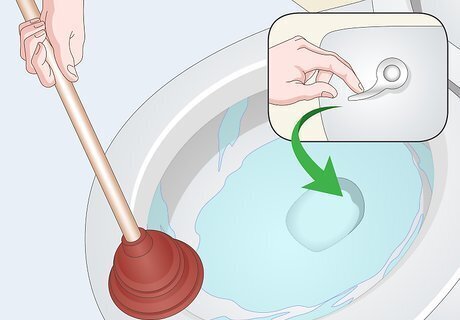
Fill the toilet bowl with more water as needed. Water has to be in the bowl in order for plunging to be effective. You can flush the toilet or open the flapper in the tank to refill the bowl. The clog may even disperse as you add the water.
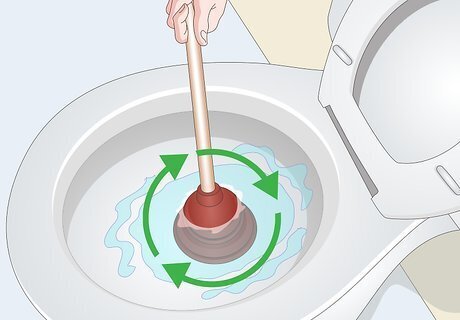
Repeat plunging as needed until the clog clears. You may need to go through a few rounds of plunging to fix your toilet. Plunge the toilet about 15 to 20 times each time, adding more water as needed to fill the bowl. Be patient to avoid splashing water as you work. If you don’t seem to be making progress after regular plunging, you may need an auger or a professional plumber.
Using a Drain Snake
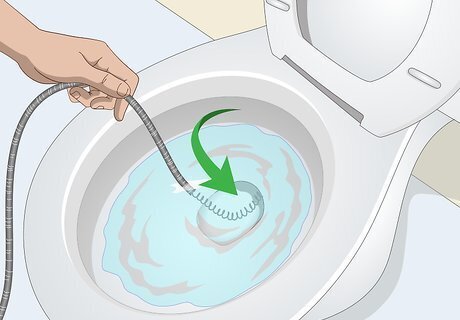
Push the end of a plumbing snake down the toilet hole. The snake will have a handle on 1 end and a corkscrew on the other end. The corkscrew end is the part that goes in the toilet. Lower it into the exit hole, pushing it as far as it will go. Any type of plumbing snake works, but the best type to get is an auger. It is designed for toilets and doesn’t scratch porcelain. You can buy plumbing snakes at most hardware or general stores.
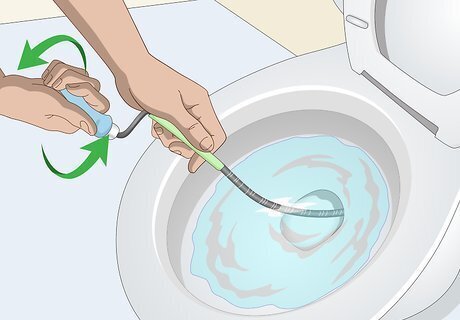
Turn the crank until the snake stops moving. Hold the snake steady with 1 hand. Use your other hand to spin the auger’s handle clockwise. This extends the auger’s wire end so it either breaks the clog or latches onto it. Crank the handle until you cannot extend the snake any further. If your snake doesn’t have a crank, rotate it by hand to push it into the clog.
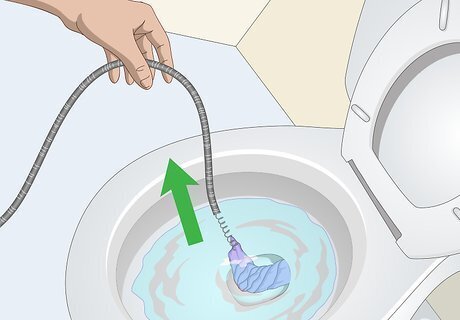
Pull the snake out of the toilet. If the clog was caused by a cloth, toy, or another object, the snake may drag it out the pipe. It may also bring back some waste or toilet paper if those were responsible for the clog. At least you can look at the end of the wire to see if it made contact with the clog. If the wire is clean and empty, it may not have reached the clog. Lower it back into the hole slowly to make sure it goes down the drain.
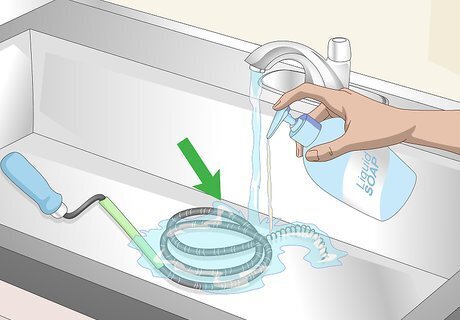
Clean the snake off with soap and water. Move the wire end of the snake to your sink. Turn on the hot water to rinse the snake and wash it off with disinfecting soap. Finish drying it off with a paper towel.

Plunge the toilet if the clog isn’t completely gone. Put your plunger over the toilet’s drainage exit. If there is no water in the toilet, you will need to flush the toilet or open the flapper to add some. Make sure the plunger fits over the whole, creating a good seal before you begin using it. The plunger should be able to force water down the pipe, lowering the water level in the bowl as it breaks up any clogs still in the pipe. If the water completely drains from the bowl, plunging is optional. However, plunging 2 to 5 times is recommended to force out any clogging material still lingering in the pipes.
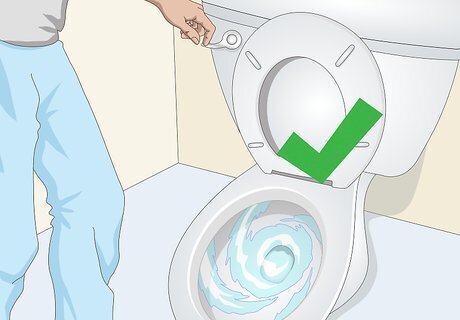
Flush the toilet to clear out the exit pipe. Give the toilet a good flush to make sure it works correctly. You may need to do this a couple of times before the water drains normally. Any remaining material from the clog will likely be swept away as the water flows. If the toilet is still clogged, try snaking the drain and plunging again. If you can’t clear the clog at all, it may be deeper in the drain. You will have to call a plumber.











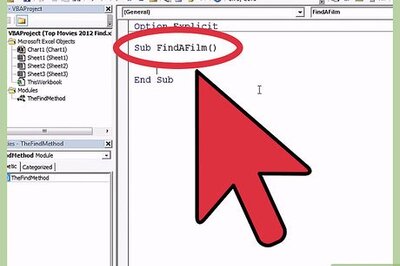








Comments
0 comment